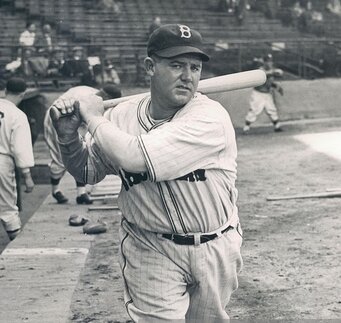Scroll Down to Read Today’s Essay
Subscribe to Baseball History Comes Alive for automatic updates (sign-up block found in right side-bar)
As a Free Bonus for subscribing, you’ll get instant access to my two Special Reports: Memorable World Series Moments and Gary’s Handy Dandy World Series Reference Guide!
Babe Phelps and the 1941 Dodgers Photo Gallery
Click on any image below to see photos in full size and to start Photo Gallery:
Baseball “Babes,” Part Five!
A Trade of the “Babes”: Babe Dahlgren for Babe Phelps!
In recent days, I’ve written about Babe Ruth, Babe Dahlgren, Babe Herman, and Babe Adams. I thought I’d go for a “clean sweep” and make it five-in-a-row with a few words about another “Babe,” Babe Phelps.
On December 30, 1943, there was a very unusual trade in major league baseball. In what most certainly was a baseball first, there was a trade of “Babes”: The Phillies sent first baseman Babe Dahlgren to the Pirates for catcher Babe Phelps and cash.
Babe Dahlgren will forever be remembered as the player who replaced Lou Gehrig in the lineup on May 2, 1939, ending Lou’s 14-year Iron Man streak of 2130 games. The other Babe in the trade, Babe Phelps, never reported to his new team, the Phillies, and instead, decided to retire to his home in Maryland and work for the railroad. He later worked as a dispatcher at Fort Meade during the WWII.
As is often the case, whenever I look into the career of a relatively unknown or forgotten ballplayer, invariably I find some noteworthy accomplishments. That is certainly true with the career of Ernest Gordon “Babe” Phelps. First of all, I discovered that Phelps was a terrific hitter and a decent all-around ballplayer, considering he spent most of his career as a backup catcher, including backing up such notables as Gabby Hartnett, Al Lopez, and Mickey Owen.
A three-time All-Star, Phelps played 11 seasons in the majors (1931-1942) for the Senators, Cubs, Dodgers, and Pirates. Over his career, he hit .310, including four seasons over .300. He also compiled 54 home runs, 345 RBIs, a .368 on-base percentage, and a .422 slugging average. His career 125 OBP+ places him well above average among his major league contemporaries (100 being the major league average).
His best season was 1936 when he put up a pretty good slash line. In addition to the .367 average, he posted a .421 on-base percentage, and a .498 slugging average, losing the batting title to Paul Waner on the last day of the season. According to his SABR biographer, Cort Vitty, his .367 mark in 1936, “…is still the record for a catcher qualifying for the batting crown.” Over the four-year period from 1935-1938, he hit for a combined average of .338.
At 6’2”, 225 pounds, the beefy Phelps—also known as “Blimp”—bore a striking resemblance to the great Bambino himself. It was even said that his left-handed swing reminded people of Ruth. In the pre-television days in which he played most of his career, more than once he was mistaken for Babe Ruth while sitting in hotel lobbies. Apparently, it was because of this physical resemblance to Ruth that his teammates tagged him with the “Babe” moniker. Ironically, in 1938, when Phelps was with the Dodgers, Babe Ruth joined the team as a coach. The two namesakes and Maryland natives, while completely opposite personality types, hit it off and became friends.
Here’s a couple other interesting facts about Babe Phelps I learned from his SABR biography:
- He scored the first televised run in Dodger history on August 26, 1939 at Ebbets Field.
- Phelps was aboard the flight for the Dodgers’ very first airplane trip on May 7, 1940, a harrowing three-hour flight from St. Louis to Chicago. After landing in Chicago, Phelps declared he would never fly again, and preferred to continue traveling by train.
- Years after his retirement he remained popular with Dodger fans, and at one time won a poll as their favorite Dodger catcher.
- He has been inducted into the Dodger Hall of Fame and the Maryland Athletic Hall of Fame.
Babe Phelps passed away on December 10, 1992, aged 84, in his Odenton, Maryland hometown. While perhaps not as accomplished as some of the other “Babes” I’ve featured in this series, Babe Phelps’ career is certainly worthy of note. As he falls into the category of “Forgotten Stars,” I’m glad as always to shine our baseball spotlight on players like him for a brief moment or two before they are completely forgotten over the passage of time.
Gary Livacari
Sources: Quote and background information from the Babe Phelps SABR biography by Cort Vitty. Click here to read more; and excerpts edited from the Babe Phelps Wikipedia page.
Add your name to the petition to help get Gil Hodges elected to the Hall of Fame (with voting now postponed until December 2021): https://wp.me/P7a04E-57h

